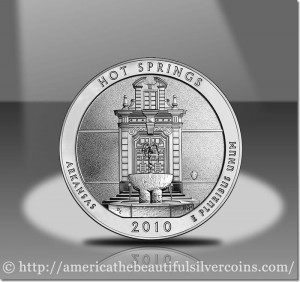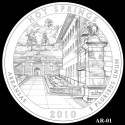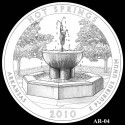The Hot Springs America the Beautiful Silver Bullion Coin is the first .999 fine silver coin released from the America the Beautiful Silver Coin Program and honors the park in the state of Arkansas.
Sales of the Hot Springs Bullion Coin began on December 10, 2010 along with the other four 2010-dated strikes of the series. Within three weeks, the US Mint’s network of authorized purchasers ordered the complete 33,000 mintage of the Hot Springs Coins (as well as all 33,000 of each of the other four strikes released at the same time).
The America the Beautiful Silver Bullion Coin Program features five ounce, 3 inch diameter silver bullion duplicates of the circulating America the Beautiful Quarters®. The obverse or heads side of the coin features the familiar portrait of George Washington. The edge is inscribed with the weight and fineness.
To put the coin’s size in perspective, it has a diameter of twice the size of early US silver dollars, like the Morgan and Peace Silver Dollars, and it is nearly double the American Eagle Silver, which is 1.598 inches in diameter and includes one ounce of silver.
The reverse or tails side of the silver Hot Springs coin matches the Arkansas 2010 Hot Springs National Park Quarter which was formally revealed on March 24, 2010. It depicts the national park headquarters building and the fountain in front.
Prior to the selection of the final design, four design candidates were created by the United States Mint who strike and issue the coins. These designs were submitted by the U.S. Mint to two major organizations responsible for reviewing all U.S. coinage — the Citizens Coinage Advisory Committee (CCAC), which consists of eleven members, and the Commission of Fine Arts (CFA), which consists of seven members.
These organizations recommended different designs, as explained below. For reference, the following are line art images of the four designs, which may be enlarged with a click:
The CCAC strongly preferred design number "AR-04" which entails the fountain in front of the Hot Springs National Park’s headquarters building. It was this design that was used as the basis for the final 2010 Hot Springs America the Beautiful Silver Bullion Coin.
"The Committee strongly recommends design 4, which shows a focused view of the public fountain in front of the site’s headquarters building," the CCAC reported to Treasury Secretary Geithner. "Members appreciated the design’s clear imagery, emphasis on water, and incorporation of natural landscape."
The CFA picked candidate number two, or "AR-02," also featuring the fountain in front of the main building, along with the doorway into that building, and suggested a slight revision.
"The Commission members commented favorably on the simplicity of this design but questioned the quality of the drawings presented, and recommended that the small National Park Service sign beside the doorway be eliminated from the design due to its illegibility at the scale of a coin," CFA Secretary Thomas E. Luebke said in a report to US Mint Director Ed Moy.
The final decision was made by the Secretary of the Treasury, as outlined in the America’s Beautiful National Parks Quarter Dollar Coin Act of 2008.
America the Beautiful Quarters and Silver Bullion will feature up to five new designs each year beginning in 2010 through to 2021. Each coin in the eleven year series will have reverse designs that represent a selected National Park or National Site in each state, the District of Columbia and U.S. territories — Puerto Rico, Guam, American Samoa, the U.S. Virgin Islands and the Northern Mariana Islands.
These coins are not sold directly by the U.S. Mint to the public, but instead to a select group of authorized buyers (coin dealers, precious metal providers, etc.) who then resell the coins.
The United States Mint will also be releasing a collector grade version of this coin known as the Hot Springs Silver Uncirculated Coin.
Hot Springs National Park in Arkansas
Known as the "the Valley of the Vapors" by Native Americans for centuries long before being "discovered" by European settlers, the Hot Springs area (located in the state of Arkansas) is thought to have been a peaceful location where tribes came together to enjoy the waters. It first came to the attention of others in 1541 when explorer Hernando DeSoto and his group ventured into the area.
In 1832, the United States Congress officially set aside the land as a reservation area giving it federal protection. This marked the first time the US Government had reserved part of the country for public use, with the intent to prevent its destruction or abuse by private individuals.
The next few decades found the area both enjoyed and yes, abused, by those interested in its benefits and the people who wanted to get rich off of them. Hot spring water (which averaged 143 degrees) was diverted and directed to several bathhouses which where constructed to provide a place for paying customers to enjoy the water, after it had been cooled some.
Hot Springs remained a reservation area until 1921, when Congress officially renamed it Hot Springs National Park. It eventually came to encompass over 5,000 acres including the surrounding hillsides. Baths are still offered by local businesses which utilize the hot springs water that they purchase from the Park.




